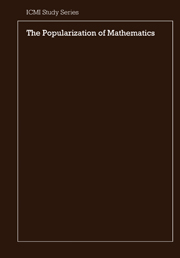Book contents
- Frontmatter
- Contents
- FOREWORD
- A Study Overview
- Mathematics in Different Cultures
- Mathematics for the Public
- Making a Mathematical Exhibition
- The Role of Mathematical Competitions in the Popularization of Mathematics in Czechoslovakia
- Games and Mathematics
- Mathematics and the Media
- Square One TV: A Venture in the Popularization of Mathematics
- Frogs and Candles - Tales from a Mathematics Workshop
- Mathematics in Prime-Time Television: The Story of Fun and Games
- Cultural Alienation and Mathematics
- Solving the Problem of Popularizing Mathematics Through Problems
- Popularizing Mathematics at the Undergraduate Level
- The Popularization of Mathematics in Hungary
- Sowing Mathematical Seeds in the Local Professional Community
- Mathematical News that's Fit to Print
- Christmas Lectures and Mathematics Masterclasses
- Some Aspects of the Popularization of Mathematics in China
The Popularization of Mathematics in Hungary
Published online by Cambridge University Press: 26 April 2011
- Frontmatter
- Contents
- FOREWORD
- A Study Overview
- Mathematics in Different Cultures
- Mathematics for the Public
- Making a Mathematical Exhibition
- The Role of Mathematical Competitions in the Popularization of Mathematics in Czechoslovakia
- Games and Mathematics
- Mathematics and the Media
- Square One TV: A Venture in the Popularization of Mathematics
- Frogs and Candles - Tales from a Mathematics Workshop
- Mathematics in Prime-Time Television: The Story of Fun and Games
- Cultural Alienation and Mathematics
- Solving the Problem of Popularizing Mathematics Through Problems
- Popularizing Mathematics at the Undergraduate Level
- The Popularization of Mathematics in Hungary
- Sowing Mathematical Seeds in the Local Professional Community
- Mathematical News that's Fit to Print
- Christmas Lectures and Mathematics Masterclasses
- Some Aspects of the Popularization of Mathematics in China
Summary
INTRODUCTION
Let us start with a quotation from J. I. Ignatyev:
“Nowadays there is hardly anybody who would deny the necessity of the most wide-ranging popularization and diffusion of mathematical knowledge. Basic mathematics should be provided already at a very early age during the process of education and instruction. .… We may expect success only if we use every-day situations, familiar topics as keys to enter the territory of mathematics by the help of problems that are, at the same time, stimulating and full of wit.” This quotation dates back to 1908 but it is in perfect harmony with the discussion document [2]. If it was necessary to popularize mathematics 80 years ago, it is more urgent now, since “there is now an increasing divergence between the advancement of science and the general understanding of the vast majority of human beings”. There are many efforts all over the world, and it is high time to collect and exchange international experiences. In this communication we present Hungarian examples and offer a few comments.
The paper is organized as a loose collection of items. These items reflect the author's experiences during 25 years of efforts for the popularization of mathematics, including the last 8 years when he was a member of the mathematical presidium of the Society for the Diffusion of Sciences, with Hungarian abbreviation TIT. Experiences gathered as a member of the community of mathematics educators are also incorporated.
- Type
- Chapter
- Information
- The Popularization of Mathematics , pp. 160 - 169Publisher: Cambridge University PressPrint publication year: 1990

